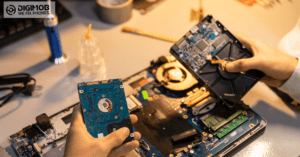We’ve all faced frustrating issues with our mobile devices at one point or another, ranging from battery problems to unresponsive screens. While seeking professional assistance is usually the best course of action for significant faults, there are instances where a little DIY troubleshooting can resolve the problem without the need for expert intervention. This is why we’ve compiled a list of top 10 mobile phone troubleshooting tips straight from the experienced technicians at Digimob Phone Repairs, South Australia’s leading mobile repair centre.
Whether you’re using an iPhone, Samsung, or any other major brand, these tips will help you identify and address common issues with your device, saving you time and potentially unnecessary repair costs. Read on to learn these valuable insights from Digimob Phone Repairs’s experts and become more self-sufficient in maintaining and troubleshooting your mobile device.
1. Restart Your Device
One of the simplest yet remarkably effective troubleshooting tips for mobile devices is restarting the device. By doing this, you’ll be resetting the device’s firmware, clearing memory cache, and closing background applications that might have caused the issue.
To restart your device, press and hold the power button until the option to turn off or restart appears. Select the appropriate action and wait for your device to power off or reboot. This process may vary slightly depending on the specific brand and model of your phone.
2. Check for Software Updates
Many mobile phone issues are caused by outdated software or compatibility issues. To ensure your device is running optimally, regularly check for and install any available software updates. These updates often include bug fixes, performance improvements, and new features.
To check for software updates, go to the settings app on your mobile device:
- For iPhones: Settings > General > Software Update
- For Android devices: Settings > System > Advanced > System Update
Follow the on-screen instructions to install any available updates, and remember to connect to Wi-Fi and ensure your device has sufficient battery power before starting the process.
3. Reset Your Network Settings
Connectivity issues, such as not being able to connect to a Wi-Fi network or experiencing problems with mobile data, can often be resolved by resetting your device’s network settings. This process will clear previously stored network configurations and return them to default settings.
To reset network settings:
- For iPhones: Settings > General > Reset > Reset Network Settings
- For Android devices: Settings > System > Advanced > Reset options > Reset Wi-Fi, mobile & Bluetooth
Note that this action will also delete any saved Wi-Fi passwords and connected Bluetooth devices, so you’ll need to re-enter or reconnect them afterwards.
4. Clear Cache and App Data
If you are experiencing issues with a specific app on your mobile device, clearing the app’s cache and data may help resolve the problem. This process will remove temporary files and stored data associated with the app, which might cause the app to function improperly.
To clear cache and app data:
- For iPhones: Settings > General > iPhone Storage > Select the App > Offload App or Delete App (you can download the app again afterwards)
- For Android devices: Settings > Apps & Notifications > See all apps > Select the App > Storage & cache > Clear Cache and Clear Storage/Data
Keep in mind that clearing an app’s data may result in losing personal information or in-app progress, so make sure to back up any vital data before proceeding.
5. Boot Your Phone in Safe Mode
Booting your mobile device in safe mode allows you to troubleshoot software issues by temporarily disabling third-party apps. If your phone functions normally in safe mode, it’s likely that a third-party app is causing the problem.
To boot your phone in safe mode:
- For iPhones: Unfortunately, there’s no built-in safe mode feature for iOS devices. However, you can try uninstalling recently installed apps to identify the source of the problem.
- For Android devices: Press and hold the power button until the power menu appears, then press and hold the ‘Power off’ option until the ‘Restart in safe mode’ prompt appears. Tap ‘OK’ to proceed.
If the issue is resolved in safe mode, you can start uninstalling third-party apps one by one to identify the problematic app. Once identified, either update or remove the app to resolve the issue.
6. Restore Your Device to Factory Settings
If none of the above troubleshooting tips work, restoring your device to its factory settings might be the last resort. This process will delete all personal data, apps, and settings, returning the device to its original state when you first purchased it.
Before proceeding with a factory reset, make sure to back up any important data, such as contacts, photos, and app data. Follow the steps below to perform a factory reset:
- For iPhones: Settings > General > Reset > Erase All Content and Settings
- For Android devices: Settings > System > Advanced > Reset options > Erase all data (factory reset)
7. Inspect the Charging Port and Battery
If your device is experiencing charging or battery-related problems, it’s important to check the charging port and battery for any visible damage or debris. A dirty or damaged charging port can cause intermittent or no charging at all. Gently clean the charging port with a toothpick or small brush to dislodge any dust or debris.
Additionally, check for any physical swelling or bulging of the battery, which could cause the device to malfunction or pose a safety risk. If you notice any battery swelling, it’s best to turn off the device and contact an expert technician at Digimob Phone Repairs immediately.
If none of these tips resolve your mobile device issues, seeking professional assistance may be necessary. Digimob Phone Repairs’s experienced technicians are readily available to help diagnose and repair your device, ensuring that your smartphone is back up and running in no time.
Trust Digimob Phone Repairs for Expert Mobile Device Solutions
These mobile phone troubleshooting tips can come in handy when dealing with common device issues. However, it’s essential to recognise that certain problems may require professional intervention. If the issue persists or you’re not confident in performing these troubleshooting steps, Digimob Phone Repairs is here to provide expert assistance for mobile device repairs.
With years of experience and an unwavering commitment to customer satisfaction, Digimob Phone Repairs is the go-to repair centre for mobile users in South Australia. Their skilled technicians can diagnose and resolve a wide range of problems across all major device brands and models.
For reliable and professional mobile phone repairs and other services you can trust, contact the friendly team at Digimob Phone Repairs. Let us take care of your mobile phone concerns, so you can continue enjoying a seamless and hassle-free smartphone experience.


